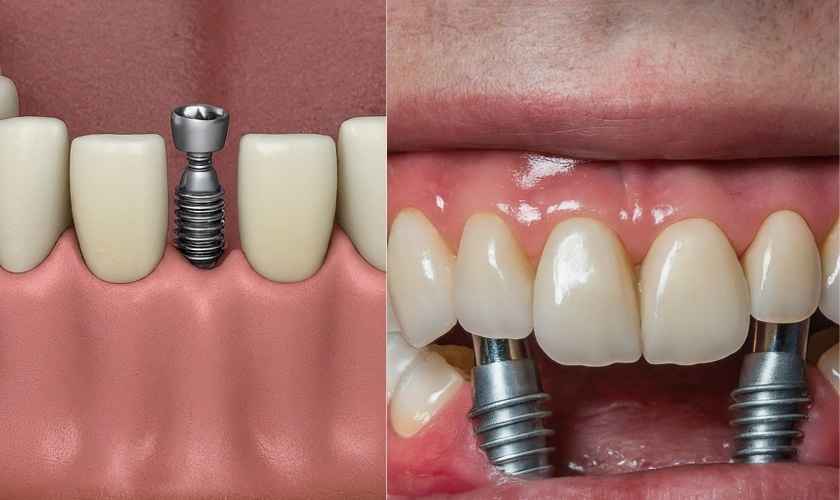Some Known Factual Statements About Dental Sense
Some Known Factual Statements About Dental Sense
Blog Article
8 Easy Facts About Dental Sense Described
Table of ContentsDental Sense - TruthsMore About Dental SenseDental Sense for BeginnersThe Basic Principles Of Dental Sense
are clinical devices operatively dental implanted into the jaw to bring back an individual's capability to chew or their look. They supply assistance for fabricated (phony) teeth, such as crowns, bridges, or dentures. When a tooth is shed due to injury or condition, an individual can experience problems such as fast bone loss, defective speech, or adjustments to eating patterns that result in pain.Dental implant systems include a dental implant body and oral implant joint and might additionally consist of an abutment addiction screw. Dental implant vs bridge. The dental implant body is operatively put in the jawbone in place of the tooth's origin. The oral implant joint is normally connected to the implant body by the joint fixation screw and expands via periodontals right into the mouth to sustain the affixed artificial teeth
(https://www.domestika.org/en/dentalsense1)Framework of The Oral Implant System picking oral implants, talk to your dental supplier regarding the potential advantages and threats, and whether you are a candidate for the procedure. Points to consider: Your overall wellness is an important variable in figuring out whether you are a good prospect for oral implants, just how long it will require to recover, and for how long the dental implant might remain in place.
Smoking cigarettes might influence the healing process and lower the lasting success of the implant. The recovery procedure for the dental implant body might take several months or longer, throughout which time you commonly have a short-term joint in place of the tooth. the dental implant procedure: Thoroughly follow the dental hygiene guidelines offered to you by your dental supplier.
Indicators on Dental Sense You Need To Know
Implant failure can cause the demand for one more surgery to repair or change the implant system. Restores the capacity to chew Restores cosmetic appearance Assists maintain the jawbone from shrinking due to bone loss Preserves the wellness of the bordering bone and gum tissues Aids keep adjacent (close-by) teeth secure Improves lifestyle Damage to bordering natural teeth during dental implant placement Injury to the surrounding cells during surgical procedure, such as sinus perforation Injury throughout surgical procedure (for instance, crack of surrounding jawbone) Poor feature, such as feeling like the teeth do not bite together generally A feeling that the tooth is loosened or turning in location arising from a joint screw loosening Implant body failing (looseness of the dental implant body) as a result of systemic infection, which may be more probable in individuals with uncontrolled diabetes mellitus as a result of regional infection in bone and periodontals supporting the implant body due to postponed healing, which might be more probable in clients that smoke Trouble cleaning the periodontals around the implant, causing poor dental hygiene Neglected gum condition Post-surgical numbness because of nerve impingement or damages Constantly inform healthcare suppliers and imaging professionals that you have dental implants before any magnetic vibration imaging (MRI) or x-ray treatments.
FDA is not familiar with any kind of damaging events reported for MRI or x-ray procedures with dental implants. Dental implants systems are normally made from materials that adhere to international consensus standards of the International Organization for Standardization (ISO) or ASTM International. These criteria have information of what makes a secure material.

A dental implant is a framework that changes a missing out on tooth. With screw-like gadgets, the specialist inserts a dental implant into the jawbone, and it works as an anchor for an artificial tooth, called a crown. A tool called an abutment links the artificial tooth to the dental implant. The crown is customized to fit the person's mouth and match the color of their teeth.
10 Easy Facts About Dental Sense Explained
Some individuals are not eligible for dental implant surgical procedure. It is for oral doctors to operate people with: acute illnessuncontrollable metabolic diseasebone or soft cells illness or infectionIf these issues are dealt with, an individual can have the surgical treatment. In, dental cosmetic surgeons abstain from operating individuals with: If individuals with any of the above go through oral implant surgery, there is a greater risk of the implant failing.

Oral implant surgical procedure is a tailored process. It's not the same for every person. But the complying with provides a general introduction of what you can anticipate your dental expert, dental surgeon, periodontist or prosthodontist to do: Position the dental implant operatively. Provide you time to recover. Connect the message and last crown, bridge or denture.
Next off, your surgeon will thoroughly position the dental implant into your jaw. Your surgeon will certainly rearrange your periodontals and shut the incision with stitches. If your dental implant is near the front of your mouth, your dental expert will certainly make a temporary tooth for you to put on until you recover. In this way, you will not have a gap in your smile while you recover.
The Only Guide to Dental Sense
Throughout the recovery stage, your jawbone must fuse to the dental implant. This process can take anywhere from three to nine months.
Once your implant heals, your dental professional can affix the joint (little port post) and your final remediation (crown, bridge or denture). This normally takes concerning one hour to complete and might need a second minor surgery. You should not really feel any type of discomfort throughout your dental implant treatment because your provider will certainly use medicine to try this web-site numb your gum tissues.
Report this page